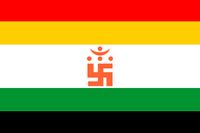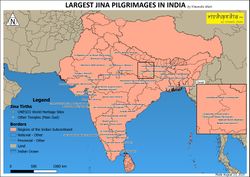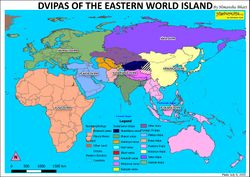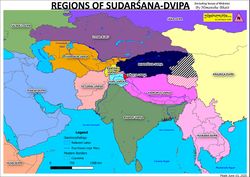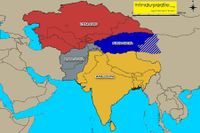Jain Dharm
Jainism is also known as Jain Dharm, Jin Dharm, Jinmārga, Jinśāsan, Jinvachan, Jinvāni, and Nirgranth Dharm, Nirgranthśāsan, Vitarāgamārg, Anekāntadarśan, Arhat Dharm. It is an Arya dharm, like Sanatan Dharm, Bauddh Dharm, Sikh Dharm, and Bonpa Dharm. This means that it is a religion that is based on the Doctrine of Moksha. It, like the Sanatan and Bauddh dharms claims to be an Astika darshan.
Jainism recognizes two fundamental principles. They are:
These two principles come into contact with one another and forge certain energies that bring forth birth, various experiences of life and death. There is a five-fold ethical code in Jainism. It is as follows:
- Ahiñsā - non-violence
- Satya - truth
- Asteya - non-stealing
- Brahmacharya - celibacy
- Aparigraha - non-acceptance of gifts
Jains consider themselves as Hindus,[1] and it was actually Dayanand Saraswati who had urged government legislation to have them recognized as distinct from the Hindu community.
"the kinship of the religions of India stems from the fact that Jains, Buddhists and Sikhs look back to Hinduism as their common mother."[2] - S. Vernon McCasland
Pan-Hindu monarchs, while being devout to a particular sect themselves were open to accepting and supporting their family members being of any other sect. King Kharvela the Jain king of Kalinga was called a "sarva pasanda pujaka"[3] and "sarva devayatana samskarana".[4][5] Line 17th of his Hatigumpha inscription also reveals that he repaired the temples of all the deities.[6][7]
Origin of Jainism[edit]
The origin of Jainism is such that it claims to be established by Kashyapa (perhaps refering to Rishabha, who was of Kashyapa gotra), or in one case Gautama[8]. He has also been known as Adinath, Adiguru, Adiśvara, Koṣālika, Nabheya, Vriśabhasena, Yugadijina, and Yugadiśa.
We do know that the first Tirthankara[9] was Rishabha and that he preached the dharma if various parts of India. His son Bharat further became a Chakravarti whose suzerainty extended to beyond India. This spread Jainism as well, and is the reason why two known Tirthankars (Simandhara, Yugandhara) apart from the 24 of India were born in ancient Uyghurstan and Afghanistan.
Jains have historically also been known as Nirgranthas (Without knots), Nagnas (Naked ones, referring to the mendicants), Nainars (in Tamilnad), Kshapanakas, Bhavnas, and Bhavyajanas. Collectively they are known as the Ćaturvidha Sangh or Ćaturvarna Sangh (Four-fold Order), and Ćaturvarga which means the same.
Jain temples are typically referred to as mandirs, though are also more specifically known as jinalayas, siddhayatans, and sasvata-caityas.
Harmony of Jainism with other sects[edit]
Jain Dharma has been harmonious with other sects, including mainstream Hindu Dharma.
Haribhadra wrote of Shiva as Mahadeva and him being the jina free from all passions, on the cult, knowledge, renunciations, etc.[10]
Malli Reddi though a Jain himself of a Jain family is said to be the uplifter of four doctrines (Jain, Shaiva, Vaishnava, and Bauddha.) He even built 21 temples to merit his ancestors up to 21 generations.[11]
Mandala Purusha's Suddmani Nigandu or Sulatnani Nigandu dictionary uses the same generic word to refer to deities of different doctrines whether for Jina, Brahman or Pangayan, Siva, or others.[12]
Asadhara composed the Jinasahasranama in the mid-13th century and it in the Jina is repeatedly compared with Mahadeva Sadasiva and Brahma.[13]
Ravisena identifies Rishabhadeva as Shiva and Swayambhu. In the Mahapurana of Jinasena-Gunabhadra, the Jina is called the creator and destroyer of the universe.
| That which is formless is given a form (rupa.) He is the form of the universe, the Lord of the World. It is the embodiment (murti) of enlightenment (kevala-jnana), the one who has conquered all passions, the Jina lord. The embodiment of the Jina shows the teacher of the world as absorbed in The Ultimate (Brahma).[14] | ||
—Jaya Samhita | ||
Hemchandra was the one who gave advice to King Kumar Pala to rebuild Somanath pilgrimage temple after it was plundered and destroyed by Mahmud Ghazni, according to the Bhadrakali inscription.[15] Then aggressive sectarian priests pressured him to pay homage to the Shiva statue at the temple. Hemchandra replied with piety towards the statue and said, "I bow to all those who have overcome the attachment and hatred that are the cause of worldly existence, be they Brahmā, Vishnu, Shiva or Jina."
An inscription belonging to Saundatti town Ratta Dynasty's period reads[16]:
- Jayanti yasyāvadato 'pi bhārati
- Vibhutayas tirthakrto'pi...
- Sivāya dhātre sugatāya visnave
- jināya tasmai sakalātmane namah
This shows the belief that all Hindu religions, whether Shaivism, Buddhism, Vaishnavism, Jainism, or others, they are all valid according to Jainism.
A silasasana in Belur from 1380 CE declares that Lord Kesava of Belur is identical with "whomsoever the Vedāntins in their heart adore under the name of Brahm, or the Saivites under the name of Siva, or the Bauddhas under the Buddha, the Naiyāyikas skilled in the pramanas under the name of Kartā, whomsoever the Jains understand by Arhat, whomsoever the Mimāmsakas call Karma."[17]
A Jain inscription reads[18]:
- Yo viṣvam vedavedyam jananajalanidher bhanginah pāradrṣvā
- paurvāparyāviruddham vacanam anupamam niṣkalankam yadiyam
- tam vande sādhuvandyam sakalagunanidhim dhvastadoṣadviṣantam
- buddham vā vardhamānam ṣtadalinilayam keṣavam vā ṣivam vā
Kerala's St. Ilangovadigal had used epithets of Brahma and Shiva for Tirthankaras.[19]
Celini, a Vaishnava of the Sinhdudesi royal family married Srenika the Jain, and the two stayed in their respective religions.[20]
Brahm in Jainism[edit]
- See also: Brahm
Although Jain scriptures normally focus on achieving the statehood of the Jina, rather than explain a Supreme Jina to which all Jinas belong, there latter does find mention. The notion of a Supreme above all is clear in some Jain scriptures. There has been association between Tirthankaras and Brahm (Brāhman) within the texts. The second, Tirthankar, Ajita in the Svayambhu Stotra[21] is described as "Brahma-nisṭha"[22] and is requested to bestow "Jinasri" on the devotee.[23] Later in the same scripture,[24] Brahmā is described of as being the highest principle, "ahiñsa bhutanam jagati viditam brahma paramair." There is also Jinesvara Suri's Gaharayanakoṣa scripture which begins first with a prayer to Jina, and then Brahman.[25]
The name Brahmā (not to be confused with Brāhma) has been used in Jainism also in titles conferred on both Jain scholars and temples. Hasmukhlal Dhirajlal Sankalia suggests that names like Brahmasaraṇu suggest the person has realized or is after Brahman [26] There were some great scholars who took this title and examples are Brahmachintamani, Brahmaguṇadasa, Brahmajinadasa, Brahmajinasagara, Brahmananka, Brahmapunyasagara and Brahmasantidas. Furthermore, the Parsvadeva Basadi, a temple of Parshvanatha of Tailangere is known as Brahma Jinalaya.
Some scholars make it clear that Brahman is an entity and Supreme Brahman and even compare it to personifications of God Almighty. The Jain Scholar Yogindu called Paramātma by many names including Brahman and Jinadeva.[27] He writes, "Jinadeva is present in all the temples of the body and man would be fool to seek him in temples." He compares the perfection of Jina to other names that the perfect entity is called. The body, etc. are not the highest self that is here known stainless (nirmala), timeless (niṛkala), pure, Jina, Śiva, Viṣṇu and peaceful.[28] He also says, "If the highest Brahman is not realized through great meditation one has to wander infinitely suffering the miseries of transmigration."
A few scholars have made it a required belief to believe in the Supreme Jina. Achārya Vijay Bhuvanbhanusuri writes, "If philosophers do not believe in the omniscient Jinendradeva as the reverend Supreme Lord, then there is no Jainatva[29] in them." A Jain scripture says one "should center one's mind, heart and soul in mastering intellectual recognition-perception of the Supreme Self through philosophic erudition and thus ultimately become himself the Lord of Lords namely the dispassionate Jinendradeva."[30]
In the Mahāpurāṇa of Jinasena-Guṇabhadra, the Jina is called the creator and destroyer of the universe. The following is an excerpt from a Jain scripture:
- That which is formless is given a form.[31] He is the form of the universe, the lord of the world. It is the embodiment (murti) of enlightenment (kevala-jnāna), the one who has conquered all passions, the Jina lord. The embodiment of the Jina shows the teacher of the world as absorbed in the ultimate (Brahmā).[32]
Sureśvara was the chief disciple of Adi Shankar Acharya and he used the word ātmā to connote the Brahman at times and other times the jivatma.[33] Digambara Jain scholar Vijayananda in his Astasahasri quotes Suresvara's Brhadaranyakopanishad-bhasya-varttika.[34]
Many Jains, especially renowned scholars have denied that Jainism is atheist. Renowned Jain philosopher, Vijayasena Suri in the court of Akbar when accused of preaching atheism declared that Jainism's belief is not atheistic and is similar to the Sañkhya of Kapila.[35] Sañkhya advocates a Nirguṇa Atman[36] or a plurality of selves.[37]) Similar to this view, some advocated monism. The Ekavada or monism is discussed by some Jains. One commentator even refers to the Upaniṣadic idea of Brahman.[38] It corresponds to the Buddhist idea of Ekaccasassatavada mentioned in Brahmajala Sutta.
Five Heavens[edit]

There are 5 swargas identified in Jain sastras. The higher ones are in descending order[40]:
- Urdhavaloka
- Devaloka
- Graiveyika
- Anuttaravimana
- Mokshaloka
Jainism and Vedic scriptures[edit]
Jainism not nastika doctrine[edit]
Scholar Annāsaheba Latthe writes that Jainism cannot be called a nāstika doctrine because some its Tirthankaras are "worshiped and praised" in the Vedas.[41] Jains themselves have been branded nāstikas for not accepting the Vedas and they in turn have accused many non-Jains of being Nāstikas. According to Jainism, nastikavāda is a system of beliefs that are nāstika in nature. Jains assign the term nāstika to one who is ignorant of the meaning of the religious texts[42] or those who deny the existence of the soul.[43]
The Jains acharyas, Maṇibhadra and Haribhadra associated Jainism of āstika classification and associated the Lokayata (Charvaka) philosophy and pro-Vedic Vedānta with nāstika.[44]
Tirthankaras in Vedic scriptures[edit]
Some mainstream Hindu scriptures like the Purāṇas clearly mention the Tirthankaras. It is now accepted that Vedas and other Vedic scriptures do too.
| Tirthankara | Translation | Passage | Veda |
|---|---|---|---|
| Riṣabha | But Riṣabha went on, unperturbed by anything till he became sin-free like a conch that takes no black dot, without obstruction ... which is the epithet of the First World-teacher, may become the destroyer of enemies | Ṛgveda[45] | |
| Riṣabha | Om namo arhato Rsabho, om Rsabhah pavitram. Om trataramindram Rshabham vadanti amrtaramindram |
||
| Ariśtanemi | So asmakam Aristanemi svaha Arhan vibharsi sayakani dhanvarhanistam yajatam visvarupam arhannidam dayase | Ṛgveda[46] | |
| Ariśtanemi | Om svasti na indro vrddhasravah svasti nah pIZsa vis'vavedrih svasti na sta'rksyo Aristanemih svasti no brhaspatir dadha'tu anena svastikena bhagavad durgciya'h |
Ṛgveda[47] / Sāmaveda[48] a/ Kaivalya Upaniṣad[49] |
The Ṛgveda mentions Ṛṣabha the 1st Tirthankara and Ariśtanemi the 22nd. The Yajurveda mentions both of them and then Ajitanatha and Suparshva too, in cantos 25 and 92. Below are documented sections of scripture that reference one or more of the 24 Jinas venerated in Jainism:
- Ṛgveda[50]
- Yajurveda[51]
- Sāmaveda[52]
- Atharvaveda[53]
- Aitareya Brāhmana[54]
- Yasknirutka[55]
- Sarvanukramanika by Kātyāyana
- Vedartha Dipika by Sadguru Śishya
- Śayana Bhāsya[56]
- Skanda Purāṇa - Prabhas Khanda[57]
- Bhāgavata Purāṇa[58]
- Markandeya Purāṇa[59]
Jain interpretation of Vedas[edit]
As mainstream Hindu scriptures don't declare the Vedas themselves fundamental to achieving Mokṣa but as holy texts, so too many Jains view them as sacred but not fundamental for Mokṣa. Vaṣiṣṭha Ṛṣi for instance, in his Dharmasutra[60] declared, "acharahinam na punanti vedah".[61]
Tamil saint Ilangovadigal wrote in his Silappadikdram of the Arihant that He is, "the Dweller in Heaven, the Foremost of the Vedas..."
The Buddhist Suttanipata makes a reference to "the Vedas of the Samanas as well as those of the Brahmans."[62] There are Jains even in modern time that believe the Jainism originates from the Veda. An example is given by scholar T.N. Dhar who visited Mathura and met with a Swami Vijayananda of the Digambara sect that made this claim.[63]
Another scholar that claimed to have the compassionate message of the true Vedas is Thiruvalluvar, who is believed by many scholars to have been a Jain. His parentage is from a Brahman father and he was addressed "Aravalianthanan" (Brahman who possesses the wheel of dharma.[64]) Many writers have written of him and in one quote is a relationship made between him and the message of the Vedas, "Of him It is no other than Ayan (Brahma) himself, seated on the beautiful lotus-flower, who, assuming the form of Valluvar, has given to the world the truths of the Vedas, that they may shine without being mixed up with falsehood."[65] Silappadikaram quotes a verse from it. Nikakesi too quotes from it a few times, and whenever it does it proclaims of the Kural, "as is mentioned in our scripture".[66]
Further, Jain Sage Jinabhadra in his Visesavasyakabhasya cites a number of passages from the Vedic Upanishads.[67] Even many of the Vedic sages are honored by Jain scholars, for their asceticism. Sages like Yajnavalkya, Rajaputra, Nara, Nārada, Gautama, Apastamba, Angirasa, and Romapada are also mentioned in the Yasastilaka for their austerities.[68] Somadeva, author of the Yasastilaka goes on to honor the priest craft of Pingala, Matanga, Marichi and Gautama chanting the Sāman and quotes some Vedic authorities like Mānu, Vyāsa, Vasistha and others.[69]
Some historical Jain scholars have believed the Vedas actually represent metaphorical sacrifices, a claim which the Upaniṣads also endorse! In this view, the sacrifices are seen as proper human behavior to destroy desire. The Uttaradhyayana Sutra outlines the story of Jain Brahman Jayagosha confronting a staunch orthodox Vedic sage and when the sage asks Jayagosha to tell him the meaning of Vedas, the latter supplies the Jain view.[70]
Orthodox Vedic Sage: Tell us the most essential subject in the Vedas, and tell us what is most essential in the sacrifice; tell us the first of the heavenly bodies, and tell us the best of dharmas.
Jayagosha: The most essential subject in the Vedas is the agnihotra, and that of the sacrifice is the purpose of the sacrifice; the first of the heavenly bodies is the moon, and the best of dharmas is that of Kaśyapa (e.g., Riśabha).
Jayagosha: The beautiful (gods) with joined hands praise and worship the highest Lord (i.e. the Tirthankara) as the planets, &c., (praise) the moon.
According to the Dipika commentary of Uttaradhyayana Sutra by Harshakula, the "sacrifice" here means the ten virtues: truth, penance, content, patience, right conduct, simplicity, faith, constancy, not injuring anything and Samvara.
In the Uttaradhyayana Sutra, Harikeśa states:
Austerity is my agni, the soul is fire place, meditation is offering-ladle, the body is the dried cow-dung as fuel and actions are the kindling wooden-sticks;.[71]
Renowned scholar Vimalasuri in Ussesa[72] in another scripture interprets the Vedic sacrifices as metaphorical to sacrifice the animals within and that this true way is the Arṣa-Veda (Veda of Ṛṣis)[73] or the Vedas:[74][75]
"Body is the altar, mind is the fire blazing with the ghee of knowledge. This fire consumes or destroys completely the heap of sacrificial sticks of sins produced by the tree of karman.
Anger, pride, deceit, greed, attachment, hatred, and delusion-these passions along with the senses, are the sacrificed animals which are to be killed. Truth, forgiveness, nonviolence are the adequate sacrificial fee which is to be paid. Right faith, conduct, self-control, celibacy, etc., are the gods (to be propitiated). This is the true sacrifice as laid down in the venerable Vedas and expounded by the venerable Jinas. This sacrifice, when performed with complete contemplation or profound meditation, brings the reward, not heaven, but the highest nirvana (=mokṣa) liberation.
Those, however, who perform sacrifices by actually slaughtering animals go to hell just like hunters."
This "Arsa-Veda" spoken of by Vimalasuri is also spoken of by some other scholars such as Madhava and Aurobindo.[76] So then some scholars believe that originally both the Samanic and mainstream Hindu sects had the same Vedas.
Jains partaking in Vedic ceremonies[edit]
Historically Vedic ceremonies have been a part of several members of the Jain laity. Some Jain royal families of southern Kanara had Somanatha as their monarchy's official deity and even conducted worship ceremonies officiated by Jain priests.[77] The pattabhiseka ceremony for the Jain king of Vandar was performed by a Vedic Srauta priest.
Spreading of Jainism beyond India[edit]
That Jainism existed outside of India, even within Central Asia, Uyghurstan, Indochina, and Indonesia can be seen in both Jain and Buddhist writings. The term 'Jina' was popularly used by Buddhists[78] in Indonesia. Even a temple called 'Jina Dharma' with a Manjusri icon built by Aryyawangsadhirajana in 1343 СЕ (1265 Saka) is mentioned.
In the Jambudvipa Pannati Sutra, places outside of Bharat-varṣa are mentioned to also have been ruled by Chakravarti Bharat. These include Anga-loka, Simhala (Sri Lanka), Babara, Cilayoka, Javana-dvipa (Greece), Arabaka (Arabia), Romaka (Anatolia), Alasanda and Kachchha.
Jain scriptures write of 20 Tirthānkaras in Videha-varṣas (Bhadrasva, Ilāvrata, and Ketumāla), who were of that region, just as India had its own 24.
Lin-i-a was a kingdom on the southeastern coast of modern Vietnam[79], and records of contact from Southern Ch'i and Liang writings due to an expedition by the Chinese Sung Dynasty reveals that a golden statue belonging to "the Nigrantha (Jain) cult" was seized and melted down, providing enormous quantity of previous metal.[80] This theft though unholy and greedy reveals that Jainism existed in Indochina.
The earliest mention of the Pallava Dynasty's presence in Indonesia is inscribed in the Jain Lokavibhaga, which it dates to Ṣaka 380 or 458 CE in the 22nd regnal year of the Pallava king Simha Varman.[81]
Tirthānkaras in Vidahas[edit]
The Videhas (Afghanistan and Tarim Basin), had a total of 20 Tirthankars between them. The first Simandhara Swami was from Purva or East Videha (Tarim Basin) while Yugandhara Swami was from Apara or West Videha (Afghanistan.)
Achārya Kundakunda traveled outside of India and had wrote of Jainism practiced in various places abroad. Just as Buddhism and Yungdrung Bon were practiced internationally, as were Zoroastrianism (which originated in Kashmir), so was Jainism and Tirthānkaras existed abroad.
He wrote in his Pravacanasāra:
There are 5 Videhas, and each of them has 4 regional divisions (20 total regional divisions), and that 8 kingdoms (which can have 1 Tirthānkara each) exist within all of them (160 kingdoms and Tirthānkaras total.)
Sudarṣana-dvipa (which he writes as Jambu-dvipa) has 1 Videha, and can have a total of 32 Tirthānkaras (1 for each of Sudarṣana-Dvipa's the Videha kingdoms.)
Puṣkara-dvipa (which he calls 'Puṣkara-vara') has 2 Videhas, or a potential of 64 Tirthānkaras.
Kraunc̣a-dvipa (which he calls 'Dhātakikhanda') also has 2 Videhas, or a potential of 64 Tirthānkaras.
List of Tirthankaras of Maha-Videha[edit]
Apart from the 24 Tirthankaras of Bharata-varṣa, there have been 20 in between Mahā-Videha or the Videhas (modern Afghan and Tarim Basin regions), known as 'Viharamanas' (Wandering Ones.) The first of them, Simandhara Swami, was born after the era of Kunthunath and before the era of Aranath.[82] We know more about him than any of the other Viharamanas. He was born in the Puskara-Vijaya portion of Purva-Videha.
| Tirthankara | Videha | Cognizance | Yakśa | Yakśi |
|---|---|---|---|---|
| Simandhara Swami[1] |
Purva-Videha (Pundarikini city) | Bull | Chandrayana | Panchanguli |
| Yugmandhara Swami | Apara-Videha | |||
| Bahu Swami | ||||
| Subahu Swami | ||||
| Sujitnath Swami | ||||
| Swayamprabha Swami | Purva-Videha[83] | |||
| Ruśbhanan Swami | ||||
| Anantvirya Swami | ||||
| Soorprabh Swami | ||||
| Vishālprabha Swami | ||||
| Vajdhara Swami | ||||
| Chandranan Swami | ||||
| Chandrbahu Swami | ||||
| Bhuyongdev Swami | ||||
| Iśwar Swami | ||||
| Nemiprabha Swami | ||||
| Virsena Swami | ||||
| Mahābhadra Swami | ||||
| Devyaśa Swami | ||||
| Abhivirya Swami |
More Travels[edit]
Jains were definitely familiar with the geography of the world as more and more of it became discovered. Sanghadasgani in Vasudevahindi wrote abou how traders were expected to buy a license ('Pattak') for trade. He also mentions traders visited eastern Asia like China, southeast Asia like Cambodia, Java, and Sumatra, Europe like Yavanadvipa, and Africa like Algeria, Morocco, and Tunis(ia.)[84]
Kalakāc̣ārya traveled from country to country and made attempts to promote Jainism. He preached in Iran, Java, Borneo, and other nations.[85] However, just as Asoka's attempts to spread Buddhism in Greece and Asia Minor were not successful, so too did those who heard Kalakāc̣ārya's message did not adopt it. Arya Samudra, a Jain pontiff in the Upakésa-Gachchha had traveled S.E. Asian countries. Kalakāc̣ārya was successful in convincing the Saka King Haues to embrace Jainism.[86]
A major port from which ascetics diffused from was Bharukaccha (modern Bharuch.) The great Sakunikavihara was there, which had links to far regions.
List of Śalākāpuruśas or important persons[edit]
| Kāmadeva | Bāladeva | Nārāyana | Prati-Nārāyana | Ćakravarti | Tirthankara era | |
|---|---|---|---|---|---|---|
| Bāhubali | Bharata | Riśabha | ||||
| Prajāpati | Sāgar | Ajitnāth | ||||
| Śridhara | Sambhāvanāth | |||||
| Prasenaćandra | Abhinandannāth | |||||
| Ćandravarna | Sumatināth | |||||
| Agniyukta | Padmaprabha | |||||
| Sanatkumāra | Suparśvanāth | |||||
| Vatsarāja | Ćandraprabha | |||||
| Kanakaprabha | Puśpadanta | |||||
| Meghaprabha | Śeetalnāth | |||||
| Darśanabhadra | Śreyansanāth | |||||
| Śāntināth | (Himself) | (His own) | ||||
| Kunthunāth | (Himself) | (His own) | ||||
| Aranāth | (Himself) | (His own) | ||||
| Vijayarāja | Dharmanāth | |||||
| Śrićandra | ||||||
| Nalarāja | ||||||
| Hanumān | Rāma | Lakśman | Rāvan | |||
| Balirāja | Nandimitra (Mandana) | Dattadeva | (Himself) | Mallināth | ||
| Vāsudeva | Balarāma | (Himself) | Jarāsandha | Munisuvrata | ||
| Prayumna | Namināth | |||||
| Nāgakumāra | Nemināth | |||||
| Jivandhara | Pārśva | |||||
| Jambuswāmi | Mahāvira |
Philosophy[edit]
Jains in particular have placed a great emphasis on on ethics, more so than other sampradayas most of of the times.
Its system [as the Bhagavati Arādhanā affirms] is:
- Samyak-darshana (Right viewpoint or attitude)
- Samyak-jnāna (Right knowledge)
- Samyak-ćarita (Right conduct)
- Samyak-tapa (Right penance)
See also[edit]
External resources[edit]
References[edit]
- ↑ P. 95 Modern India and the Indians: Being a Series of Impressions, Notes, and Essays By Sir Monier Monier-Williams
- ↑ Religions of the World S. Vernon McCasland, Grace E. Cairns, David C. Yu
- ↑ It means worshiper of all sects".
- ↑ P. 109 Jain Journal, Volume 39 By Jain Bhawan
- ↑ It means builder of temples for all sects.
- ↑ It means "Sava devayatana sanakara karako."
- ↑ P. 144 Proceedings - Indian History Congress, Part 1 By Indian History Congress
- ↑ Mirat-i-Ahmadi
- ↑ This word appears for the first time in the Uttaradyayana and latter section of the Arcaranga; P. 53 Jaina Literature & Philosophy By Sāgaramala Jaina, Aśoka Kumāra Siṃha (Ḍô.)
- ↑ P. 539 A History of Indian Literature: Buddhist literature and Jaina literature By Moriz Winternitz
- ↑ P. 67 The Quarterly Journal of the Mythic Society (Bangalore)., Volume 90 By The Society
- ↑ .P. 625 Thirumathi Sornammal Endowment Lectures on Tirukkural, 1959-60 to 1968-69, Volume 1 By Xavier S. Thani Nayagam
- ↑ P. 31 Jainism in Early Medieval Karnataka By R.B.P. Singh
- ↑ P. 21 Framing the Jina: Narratives of Icons and Idols in Jain History By John Cort
- ↑ P. 26 Prabhas and Somnath By Shambhuprasad Harprasad Desai
- ↑ P. 186 Pandit N.R. Bhatt, Felicitation Volume edited by Pierre-Sylvain Filliozat, Satya Pal Narang, C. Panduranga Bhatta
- ↑ P. 187 Pandit N.R. Bhatt, Felicitation Volume edited by Pierre-Sylvain Filliozat, Satya Pal Narang, C. Panduranga Bhatta
- ↑ P. 187 Pandit N.R. Bhatt, Felicitation Volume edited by Pierre-Sylvain Filliozat, Satya Pal Narang, C. Panduranga Bhatta
- ↑ P. 112 A Comprehensive History of Jainism: From the Earliest Beginnings to AD 1000, Volume 1 By Asim Kumar Chatterjee; God is All Knowing, the embodiment of Dharma; He transcends the limited understanding of living beings; He is friend to all creatures; He has triumphed over the eight-fold actions; He is the Achiever, the Great One, the Root of all Dharma, the Absolute Truth, the Pure, the Ancient, the Wise, the Conquerer of anger, the foremost Deva, the Lord of the ultimate deliverance, the Supreme Being, the Virtue Incarnate He lights up the higher world; He is the great Truth, the All-Humble; He is the Charana who traverses the sky, the Root-Cause of everything, the Supreme Yogi, the Great One; He excels all; He is All-Radiant, All Pervading; He is the Great Preceptor, the Possessor of natural virtues, our Lord; He is of undiminished glory; He is the Great Leader full of goodness, the Auspicious Force, the All-Rich, the Self-Born, the Four-Headed, the Bestower of Anga scriptures; He is the Grace-Incarnate, the God, the Possessor of eight qualities, the indivisible Ancient Substance, the Dweller in Heaven, the Foremost of the Vedas, the Shining Light.
Without the illumination of the scriptures as revealed by the Supreme Lord, above-described, one cannot free oneself from the prison of births." - Silappadikdram - ↑ P. 220 Jainism in South India By P. M. Joseph International School of Dravidian Linguistics
- ↑ Svayambhu Stotra sloka 10
- ↑ It means engrossed in Self.
- ↑ P. 93 Jain Journal, Volume 37, By Jain Bhawan
- ↑ Svayambhu Stotra sloka 119
- ↑ P. 386 Journal of the Oriental Institute, Volume 41 By Oriental Institute, 1991
- ↑ Studies in the historical & cultural geography and ethnography of Gujarat: places and peoples in inscriptions of Gujarat: 300 B.C.-1300 A.D. By Hasmukhlal Dhirajlal Sankalia
- ↑ P. 4639 Encyclopaedia of Indian Literature: sasay to zorgot edited by Mohan Lal
- ↑ It means Śānta.
- ↑ It refers to Jainhood.
- ↑ P. 64 Samadhi shatak: a century of verses on concentration or self-absorption By Devanandi
- ↑ Form means rupa.
- ↑ P. 21 Framing the Jina: Narratives of Icons and Idols in Jain History By John Cort
- ↑ P. 73 Suresvara's Vartika On Yajnavalkya'S-Maitreyi Dialogue edited by Shoun Hino
- ↑ P. 72-73 A History of Early Vedānta Philosophy By Hajime Nakamura
- ↑ P. 237 A History of Gujarat: Mughal period, from 1573 to 1758 By Mānekshāh Sorābshāh Commissariat
- ↑ P. xvii Yoga Philosophy of Patanjali: Containing his yoga aphorisms with Vyāsa's commentary in Sanskrit and a translation with annotations including many suggestions for the practice of yoga By Patañjali, Swami Hariharānanda Āraṇya
- ↑ P. 379 The Principal Upaniṣads by Swami Nikhilananda
- ↑ P. 64 Jain Agamas: an introduction to canonical literature By K. L. Chanchreek
- ↑ P. 88 A Guide to Religious Thought and Practices By Santanu K. Patro
- ↑ P. 317 A Companion to Indian Mythology: Hindu, Buddhist & Jaina By Vishwanath S. Naravane
- ↑ P. 32 An Introduction to Jainism By Annasaheba Latthe
- ↑ Page i, Forms of Indian Philosophical Literature and Other Papers by V.S. Kambi
- ↑ P. 163 Mahavira: His Life and Teachings by Bimala Churn Law
- ↑ P. 173 Unifying Hinduism: philosophy and identity in Indian intellectual history By Andrew J. Nicholson
- ↑ Ṛgveda X.166
- ↑ Ṛgveda Astak 2, Varga 7
- ↑ Ṛgveda 1.89.6a
- ↑ Sāmaveda 2.1225
- ↑ P. 126 Ritual Worship of the Great Goddess: The Liturgy of the Durga Puja with By Hillary Rodrigues.) This mantra also appears in the Kaivalya Upaniṣad P. 5-6 Kaivalya Upaniṣad By Swami Chinmayananda
- ↑ Ṛgveda 8,8,24; and 10,178,1
- ↑ Yajurveda 25, 19 and 9, 25
- ↑ Sāmaveda (4, 1)
- ↑ Atharvaveda 20, 143, 10
- ↑ Aitareya Brāhmana 20, 2
- ↑ Yasknirutka 10, 12
- ↑ Śayana Bhāsya P. 678
- ↑ Skanda Purāṇa 16, 96
- ↑ Bhāgavata Purāṇa 2, 7, 10
- ↑ Markandeya Purāṇa 50, 39-41
- ↑ Dharmasutra VI, 3
- ↑ It means "Vedas do not purify one."
- ↑ P. 154 Early Buddhist Theory of Knowledge By Kulatissa Nanda Jayatilleke
- ↑ Inner World Outer World By T.N. Dhar
- ↑ P. 78 Jain Journal, Volume 5 By Jain Bhawan
- ↑ P. 59 Tales and Poems of South India By Edward Jewitt Robinson
- ↑ P. 107 A Comprehensive History of Jainism: From the Earliest Beginnings to AD 1000, Volume 1 By Asim Kumar Chatterjee
- ↑ P. 93 Studies in Jain literature by Vaman Mahadeo Kulkarni, Sresh?hi Kasturabhai Lalabhai Smaraka Nidhi
- ↑ P. 160 Brahmanism, Jainism, and Buddhism in Andhra Desa By P. Arundhati
- ↑ P. 21 Brahmanism, Jainism, and Buddhism in Andhra Desa By P. Arundhati
- ↑ Uttaradhyayana Sutra, Chapter 25
- ↑ P. 9 Studies in Buddhism By Okisa Sanskrīti Pariṣada
- ↑ canto XI
- ↑ Arsa means "speech of a Rishi"
- ↑ P. 136-137 sacrifice in India By Sindhu S. Dange
- ↑ P. 92 Studies in Jain literature by Vaman Mahadeo Kulkarni, Sresh?hi Kasturabhai Lalabhai Smaraka Nidhi
- ↑ P. 112 History of the Dvaita School of Vedanta and its literature : from the earliest beginnings to our own times By B N K Krishnamurti Sharma
- ↑ P. 71 On an Auspicious Day, at Dawn -: Studies in Tulu Culture and Oral Literature By Heidrun Brückner
- ↑ Samanera Jinananda, Bhikhu Jinapiya, Jinaputto Thera, Jinarakkhita
- ↑ P. 197 A History of Chinese Civilization By Professor Jacques Gernet
- ↑ P. 91 Bulletin, Issue 32 By Östasiatiska Museet
- ↑ P. 14 Indonesian Chronology By J. G. De Casparis
- ↑ P. 6592 Encyclopaedia of Jainism, Volume 25 Indo-European Jain Research Foundation
- ↑ P. 60 Vaḍḍārādhane: a study B. K. Khadabadi
- ↑ P. 80 History of Gujarat By S. B. Rajyagor, Pran Nath Chopra
- ↑ P. 47 Jainism: The World of Conquerors, Volume 1 By Natubhai Shah
- ↑ P. 153 ‘’Foreign Influence on Ancient India’’ By Krishna Chandra Sagar

